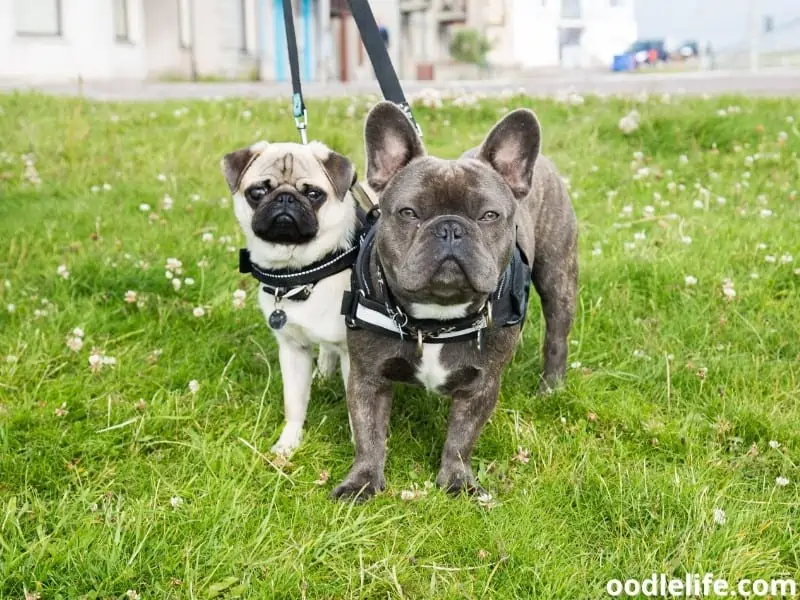Pug vs French Bulldog [Breed Comparison] Best for Your Family
Choosing a dog to welcome into your family is a difficult task. After all, every dog is a good dog. It just comes down to finding the one that best fits your lifestyle.
Despite their visual similarities, there are many differences between Pugs and French Bulldogs. We’ll explore what makes each dog unique so you can pick the breed that best aligns with your needs.

So, let’s compare Pug vs French Bulldog:
Pug vs French Bulldog Breed Similarities
While they are two different breeds, Pugs and French Bulldogs have several similarities that often lead to confusion about which is which.

Physical Similarities
Pugs and French Bulldogs are both brachycephalic breeds that have very short muzzles. With their sweet, squishy faces and bug eyes, to the untrained eye, Pugs and French Bulldogs may even look like the same breed!
Even their precious body rolls are nearly impossible to differentiate!
They are both small dogs and are low maintenance regarding their grooming needs.
Personality
These family-friendly dogs are both easy to train, fun-loving and easy-going.
Due to their small stature, both Pugs and French Bulldogs tend to be stubborn. However, they’re both people-pleasers and are very loyal to their humans.
Pug vs French Bulldog Breed Differences
As many similarities as these two breeds have, they also have quite a few differences!

Physical Differences
The average person may not be able to tell the difference between a Pug and a French Bulldog, but that’s what we’re here to help you understand.
Pugs have floppy ears and a curly, cinnamon bun tail. In adulthood, Pugs are roughly 10 to 14 inches tall and weigh between 14 to 18 pounds. They have an estimated lifespan of up to 14 years.
They need at least 40 minutes of exercise daily.
On the other hand, French Bulldogs, or Frenchies, have large “bat ears” that are their signature trait. Their tails have three shapes: straight down and stumpy, screwed and stumpy, or a thick tail with a fine tip. They grow up to 12 inches when fully grown and weigh between 16 to 24 pounds.
Their average lifespan is about 11 years.
French Bulldogs need slightly more exercise than Pugs, with at least one-hour walks ideal.
French Bulldogs also come in more colors than Pugs.
French Bulldogs come in brindle, brindle & white, cream, fawn, fawn & white, fawn brindle & white, and white & fawn. They may have the following markings: ticked, white, black markings, black mask, piebald, or brindle.
Meanwhile, Pugs are either black or fawn. Pugs, while adorable, don’t have any standard markings.
Personality
Even human twins have different personalities, so it stands to reason that these two dog breeds have differences between them.
Pugs are excellent family dogs who enjoy being around children and other animals. Whether they’re greedy when it comes to food or simply have no self-control, Pugs tend to overeat. Owners should monitor their food intake diligently.
Alternatively, French Bulldogs tend to be energetic and prefer 1-on-1 time with their owner, making them less appropriate for families or multi-dog homes. French Bulldogs don’t have the same propensity for overeating that Pugs do. However, they can quickly become obese if overfed.
Pug vs French Bulldog Temperament Differences
Pugs adore their owners, and for some people, the unlimited love and affection they give can come off as “clinginess.” While many consider this an endearing trait, people who are strongly suited to independence may find the behavior unbecoming.
Going hand-in-hand with their clinginess is that Pugs dislike being away from their humans—they do not like being alone. A vet can diagnose whether your Pug has separation anxiety issues and can work with you to develop a plan. These loving dogs can be vocal, especially when communicating their feelings with you.
French Bulldogs don’t bark very often, and because of that, they make excellent guard dogs. These lively dogs are affectionate and patient. They are a playful breed, which can sometimes come across as troublemaking or attention-seeking.
However, they know exactly what they’re doing because they’re clever.

Pug vs French Bulldog Health Issues
As mentioned earlier, Pugs and French Bulldogs are brachycephalic. Unfortunately, their short muzzles often lead to breathing problems and potentially more severe health issues in the future.
Both dogs cannot be exposed to even moderately high temperatures for extended periods without detrimentally impacting their health. Because of their face shape, they cannot pant comfortably, which leads to heat stroke and breathing difficulties. Both of these conditions can lead to an untimely death.
Due to their skin folds, Pugs and French Bulldogs are prone to Skin Fold Dermatitis, also known as Intertrigo. Skin Fold Dermatitis occurs due to friction, causing inflammation and possibly a microbial overgrowth on the skin’s surface. This ailment is likely to affect the facial fold, leading to keratitis and ulceration.
Pugs may also suffer from a central nervous system disease called Pug Dog Encephalitis. Pug Dog Encephalitis causes seizures and, eventually, blindness. Aside from Pug Dog Encephalitis, Pugs are also susceptible to other issues including hip dysplasia, luxating patella, and eye problems.
French Bulldogs may develop sensitivities to food. Because they’re prone to allergies, environmental allergens can have a detrimental impact on them. In addition, Intervertebral Disc Disease (IVDD) often affects French Bulldogs.
The disease makes them more prone to injury if they fall.
Pug vs French Bulldog Training
Both dogs are eager students and pick up on training quickly. However, because they are small, stubborn dogs with big personalities, you’ll need to be dedicated to your training regiment. As with anything, consistency is key!
Pug vs French Bulldog History
Pugs and French Bulldogs have very different historical backgrounds. In a way, this is a contributing factor related to their difference in cost. If you haven’t started shopping yet, you’ll learn that French Bulldogs are known to be more expensive than Pugs.
Pugs are older than the French Bulldog. They originated in China during the Han Dynasty. Pugs were famous for being the companions of emperors and were so beloved they were even guarded by soldiers.
Pugs were such a special breed that the only way to have one if you weren’t Emperor was to receive one as a gift from the man himself.
In more recent times, the lovable Pug became the mascot for the Order of the House of Orange, the Royal family of the Netherlands. Even the infamous Marie Antoinette owned a Pug. Needless to say, the Pug’s cute face and affectionate demeanor made it popular with royalty around the world.
The French Bulldog is a newer breed in comparison to the Pug. It first appeared in Paris around the mid-nineteenth century due to crossbreeding of Toy Bulldogs from England. Though it’s not confirmed, it’s popularly believed that the Pug was one of the breeds used to create the French Bulldog.
The new breed was called “Bouledogue Francais,” a French version of its English name. It quickly became popular in high society due to its bat-like ears. World-renowned artists like Edgar Degas and Henri de Toulouse-Lautrec have painted French Bulldogs, proving just how big of an impact the bat-eared cuties had on L’Hexagone.
Because of its hybrid gene pool, the French Bulldog breeders have to use artificial insemination to create most litters. Additionally, over 80% of births require a Caesarean section to ensure the safety of both the mother and the puppies. This contributes significantly to the difference in cost between the French Bulldog and the Pug.

What is a Frug?
A bit of a wildcard, the Frug is perfect for the person who can’t decide between a Pug and a French Bulldog. They’re an ideal mix of these two breeds and, in general, are a pleasant blend of their personalities.
Frugs are lovable and friendly. Like other small dogs, they lean toward being stubborn and difficult to train. However, that doesn’t mean it’s impossible to teach them.
As long as you are consistent and dedicated in their training regiment when they’re young, they will grow up to be well-rounded.
These low-maintenance dogs do not require much grooming or exercise and are best for owners who have the patience to train them properly.

Summary: Is a Pug or French Bulldog Better?
Choosing between a Pug and a French Bulldog is almost impossible because they’re both so darn cute! As with many things in life, both dogs come with their list of pros and cons. So, ultimately, the final choice comes down to what best compliments your lifestyle and situation.
If you have young children in your family, multiple dogs, or other animals such as cats, you may want to go with the easy-going Pug. The Pug is a friendly dog that gets along with everyone and thrives off positive attention and companionship.
On the other hand, if you’re single or don’t plan to have children or other animals in your home, the French Bulldog might be the companion you’ve been looking for all this time! French Bulldogs love their owners and enjoy the special bond between them.
Whether you choose a Pug, French Bulldog, or Frug to join your family, you’ll be in for a lot of love for many happy years!